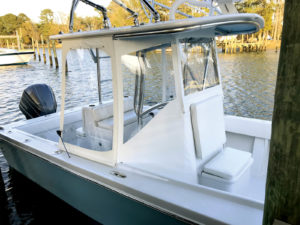Recommended fabric cleaning products

To keep this Strataglass® vinyl and other marine fabrics looking good and performing well, boat owners need to put in a little work when the day is done. Photo: Herculite.
Fabricators play an important role in teaching customers to keep their boats in shape.
It’s pretty simple. People buy boats because they want to have fun. The reality, however, is that work—the opposite of fun—is required to keep any watercraft in tip-top condition.
Therein lies the rub. “A lot of boaters don’t want to do all the cleaning and maintenance,” says Marianne Iosso, vice president of Iosso® Products of Elk Grove, Ill., which has been making marine cleaning products for more than 30 years. “They want to have fun and then just put the boat away.”
But skipping the work is not good for boats, and it’s not good for fabricators. No fabricator wants boat owners coming back to the shop with complaints that their marine fabric looks terrible, even if it’s due solely to a lack of upkeep.
Fabricators can help their customers—and themselves—by stressing the importance of maintenance and by providing accurate and thorough information about how to care for, clean and store their boat fabrics.
All fabric needs care
It starts with helping boaters understand that even the best, toughest fabrics need to be taken care of. “It’s not unusual for people to think that boat fabrics are indestructible because they’re ‘outdoor’ fabrics,” explains Lindsay Zientek, sales and marketing event coordinator for Gold Eagle Co. of Chicago, manufacturer of 303® products. “That’s not the case. Any fabric, if you don’t take care of it, will degrade.”

Boat owners need to use the right cleaning products to maintain the value of their marine investment. Herculite Products Inc., parent company of Strataglass®, recommends use of cleaners from IMAR Products LLC for its marine fabrics. Photo: Herculite.
For boat owners who want to make cleaning simple, a hose and water is a good start, but even that seemingly simple process needs to be done correctly.
“Many times an owner will take their boat out all day, come back and maybe hose off the salt water and dirt, put the cover on and leave the boat,” says Steve Szenay, marine products manager for Serge Ferrari North America, a leader in producing fabrics for the boating industry, located in Pompano Beach, Fla. “But that’s where problems arise. When you cover up the boat with water still present, you create an environment for mold and mildew to grow. Canvas and upholstery should be stored only when dry.”
Soap, not detergent
Adding a mild soap to the equation “can do wonders,” Szenay says. Again, however, there are rules.
“Like when you’re cleaning a car, you don’t want to just go under the kitchen sink and grab just any kind of soap,” says Peggy Foor, manager at IMAR Products LLC, of Manassas, Va., which has been selling boat-detailing products since 2002. “Many ‘soaps’ are actually detergents, which are a lot harsher on a surface and shouldn’t be used.”
The solution for the most effective cleaning is to use specific kinds of products for specific types of cleaning.

All marine fabrics, no matter how tough, need to be properly cleaned and maintained, and one size does not fit all–each component should be cleaned with a product made specifically for that fabric. Photo: Charlton Marine Canvas.
According to Szenay, there are more than 40 different types of materials for boat covers and tops alone, and there’s a right—and wrong—way to clean and maintain every one of them. That’s why, he says, fabricators and boat owners—or anyone charged with the job of cleaning—are best served by following manufacturers’ instructions for maintenance, including using the products they recommend.
“Manufacturers compile instructions for a reason,” Szenay says, “and it’s incumbent on fabricators to provide the information directly to their customers and to show them where it can be found online.”
Right product for the right purpose
An example of knowing the right product for the right purpose, Foor says, might be marine surfaces that have a coating to make them scratch-resistant, such as the clear vinyl sheeting sold as Strataglass®. To protect that coating, Strataglass recommends IMAR’s Protective Cleaner #301 and Polish #302 and gives guidance on its website about how to use the products.
You’ll hear the same strategy from Brett Baird, southern regional sales manager for Trivantage®, the nation’s largest business-to-business supplier for the awning, marine, upholstery, shade sail and related industries, based in Glen Raven, N.C. “Many of our customers’ covers and enclosures are made from several different components, each requiring a different cleaning method,” Baird says. “That’s why it’s important for customers to pay special attention to the product manufacturer’s care and cleaning instructions.”

Mike Charlton, owner of Charlton’s Marine Canvas, cleans a customer’s boat outside his shop in Norfolk, Va. Boat owners need to “take the time and make the effort” to keep their vessels in good shape, Charlton says.
For example, Trivantage sells Aqualon® Edge marine fabric, popular for boat covers. Without instructions, a boat owner might choose to clean the fabric with alcohol or use a high-pressure washer, Baird explains, either of which “could cause the vinyl resin coating to come off and expose the fabric’s substrate, which can degrade the fabric’s tear strength and overall performance.”
Another tip from Szenay is that boat owners should not assume that cleaners they hire will always do things the right way.
“When you go down to the marina and watch a cleaning crew washing down their customer’s boat, they will wash the fiberglass, windshield, deck, upholstery and canvas all with the same brush and cleaner,” Szenay says. “That’s because they get paid for the job by the hour and the quicker they can get done, the more money they can make.” Boat owners, he says, should not be afraid to explain how they want their boat cleaned and with what products.

Clear vinyl that’s been coated for scratch resistance requires special care when cleaning. Boat owners can check with manufacturers for care and maintenance tips. Photos: Charlton Marine Canvas.
Make cleaning easier
Recommending effective products that are easy to use is half the battle. Here are some tips from experts to pass along to your customers:
Because it’s hard enough to get a boat owner to use one product, let alone two, Zientek says Gold Eagle’s 303® Mold and Mildew Cleaner and Blocker is made to remove mildew and mold and also to prevent stains from coming back.
If you get odors from mold or mildew, or an unpleasant scent when you open the boat up at the beginning of the season, Marianne Iosso recommends a product such as Iosso Products’ Odor Buster, which encapsulates and removes the smell, rather than masking it with perfumed chemicals.
IMAR representatives frequently talk with fabricators about the company’s products and how to use them, Foor says. “We’ve even put together kits containing various products and encourage fabricators, when doing a job, to give them as a ‘thank-you’ gift. It’s a nice way of saying you appreciate doing their job.”
The bottom line? It may be a challenge to convince boat owners to take the time and make the effort to keep their investment in good condition, but it’s in a fabricator’s best interest to give it the old college try. “I always tell customers what to use to make their fabric last as long as possible,” says Mike Charlton, owner of Charlton’s Marine Canvas in Norfolk, Va. “Many people don’t use anything, some just use soap and water, and only the rare person is picky and will look up the right products and do the right things because they want their boat to last longer.”
“Some of the canvas I do looks destroyed after the first year, but some looks pretty darn new five years later,” Charlton says. “The difference? That’s easy. One owner listened and took care of it and the other didn’t.”
Jeff Moravec is a freelance writer from Minneapolis, Minn.
 TEXTILES.ORG
TEXTILES.ORG 






